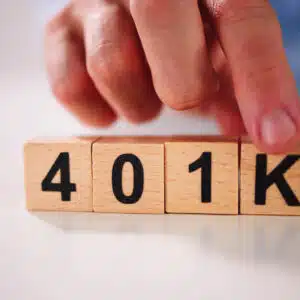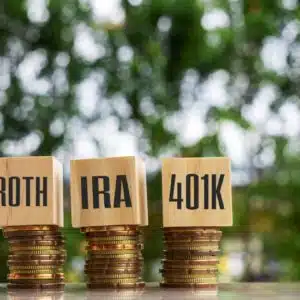Welcome to another Ask GFC! If you have a question that you want answered, you can ask it here.
If your questions get featured on GFC TV or the GFC Podcast, you are the lucky recipient of a copy of my best-selling book, Soldier of Finance, and a $50 Amazon gift card.
So what are you waiting for? Ask your question now!
I might have been waiting my entire professional life for someone to ask this question, and someone finally has! GFC reader Ron M. asked the following question:
If we think taxes are going to be higher in the future, does it make sense to invest in tax deferred accounts? I like the idea behind the ROTH but contributions are very limited. How would you advise someone in that position?
– Ron M.
Thank you, Ron. This is an outstanding question.
The general assumption is that we save money through tax-deferred accounts while we are working and in a higher tax bracket. We then withdraw the money in retirement when we are in a lower tax bracket.
But that assumption may not be true, certainly not for everyone.
Taxes could actually be higher by the time you retire than they are right now. It could happen either because tax rates are increased in the future or because you may find yourself earning more money during retirement than you are right now.
After all, right now, you are living on a paycheck, but when you retire, there may be Social Security, pension income, income from retirement savings, and even some continuation of income from a job or business.
Either situation can put you into a position of dealing with higher tax rates in retirement than what you are facing right now.
If so, do tax-deferred accounts make sense?
Tax-Deferred vs Tax-Free
On a day-to-day basis, I’m not sure that everyone fully comprehends the difference between the two. Tax-deferred means that the assessment and payment of taxes are put off until a later date. Tax-free means no taxes, ever. I’m not sure that that difference is fully appreciated when people are funding their tax-sheltered retirement plans.
With the exception of the Roth IRA, virtually every other tax-sheltered retirement plan is tax-deferred. It’s a good deal in that your contributions are tax-deductible, and the investment earnings accumulate in the plan without immediate tax consequence. But the day will come when taxes will be due on both your contributions and the investment earnings in the plan. That day will come when you retire and you begin taking plan distributions.
The point is, again, with the exception of the Roth IRA, no tax-sheltered retirement plan actually provides you with true tax-free withdrawals when you retire. That means that you are actually backloading – or deferring – the tax liability to a future date.
When we assume that we will be in a lower tax bracket when we reach retirement age, we’re really speculating. In truth, we have no idea what tax rates will be by then or even what our own individual income and tax situations will be.
Getting back to Ron’s question, we need to clearly establish the difference between tax-deferred and tax-free. Most retirement plans will merely be tax-deferred. They will not help if we’re in a higher income situation.
Accounts That Will Be Taxable in Retirement
I believe that much of the confusion between tax-deferred vs. tax-free in regard to retirement plans is the result of the fact that most retirement plans are incredibly tax-advantaged while we are building them up. Not only are the contributions tax-deductible, but the investment income activity creates no immediate tax liability.
With that kind of scenario, it’s easy to confuse the ultimate tax status of such accounts.
But as I’ve already said, most retirement plans are tax-deferred, not tax-free. The list includes:
Traditional defined benefit plans are also taxable, though increasingly few people are covered by them anymore.
The point is that you can accumulate a considerable fortune in one or a combination of these plans. The tax deductibility of contributions and the tax deferral of investment income makes that even more possible. But if you retire with $1 million or substantially more, you could be looking at a hefty tax liability when you start taking distributions.
Complicating this is the fact that, at some point, you will be required to begin taking distributions from the plan. In fact, a provision known as required minimum distributions or RMDs, means that you will be required to begin taking distributions from your plan once you turn age 73.
If you wait that long to begin taking distributions, your plan may be even larger than what you imagine right now. Since the RMDs will be calculated according to a predetermined IRS formula, you’ll have no ability to reduce the distributions in order to lower your income tax liability.
It’s not an exaggeration to say that large tax-deferred retirement savings plans are potentially ticking time bombs, at least in regard to income tax liability.
Accounts That Will be Tax-Free in Retirement
Fortunately, there are ways to save money for retirement that are actually tax-free and not just tax-deferred.
Several times, I’ve mentioned the Roth IRA as an exception, and it truly is. A Roth IRA works much like a traditional IRA in that you can contribute up to $7,000 per year (or $8,000 if you are 50 or older), and the investment earnings on it are tax-deferred (this will matter only if you take early distributions, as the earnings will be taxable if you do).
But a Roth IRA departs from a traditional IRA in three very important respects:
1. The contributions you make to a Roth IRA are NOT tax-deductible,
2. Distributions from a Roth IRA are actually tax-free if you are at least 59 1/2 years old, have participated in the plan for at least five years, and
3. RMDs are not required with a Roth IRA, meaning that distributions from the plan will not increase your tax liability (the Roth is the only tax-favored retirement plan that is not subject to RMDs)
If you anticipate having a very large retirement portfolio, a Roth IRA is a brilliant tax diversification and a virtual must-have account.
Apart from a Roth IRA, you can also save money for retirement outside of dedicated retirement plans. This means saving up money in stocks, mutual funds, exchange-traded funds, or real estate investment trusts in a regular taxable investment account.
There will be no tax deduction for contributing to these accounts, nor are the investment earnings tax-deferred. But since the money accumulates on an after-tax basis, you can withdraw it at any time – including retirement – without increasing your tax liability.
Best Strategy: Be Prepared for Anything!
Ron asked if tax-deferred accounts would make sense if tax rates were higher in retirement. In my opinion, they will, but we also need to consider this in the broadest sense possible.
Part of the reason I believe tax-deferred accounts still make sense, even with the prospect of higher taxes, is that we can’t know if that will be the outcome. We’re attempting to predict the future here, and that can never be done. Having tax-deferred accounts will see you well-prepared in the event your tax rates are lower. We can’t discount that possibility.
Ultimately, the best strategy is balance, which means being prepared for either outcome.
If you have tax-deferred accounts, you will be prepared for lower tax rates when you retire. But given the possibility that rates may be higher at that time, you should also include tax-free investments in the mix.
That should certainly start with a Roth IRA. Yes, Ron, contributions to the plan are low, but you can always do a conversion of other tax-deferred retirement accounts to a Roth IRA, increasing the size of the account substantially.
You can also supplement your Roth IRA account with regular taxable investments that are held outside of a retirement plan. Yes, the earnings on those plans will continue to be taxable, but your withdrawals will not be. You can take money out of those accounts anytime you want without creating a tax liability.
So, the short answer to Ron’s question is to be prepared for both higher and lower tax rates in retirement. That means having both tax-deferred and tax-free savings. With that strategy, you can’t lose, no matter what happens.
The Bottom Line – Do Tax-Deferred Accounts Make Sense if Tax Rates Will be Higher?
In addressing Ron M.’s intriguing question on the viability of tax-deferred accounts amid potential future tax hikes, it’s essential to differentiate between tax-deferred and tax-free investments. The typical presumption is that one will find themselves in a lower tax bracket post-retirement.
However, considering potential changes in tax rates or unexpected retirement income, this might not always be the case.
While tax-deferred accounts like 401(k) plans, Traditional IRAs, and others offer immediate tax benefits, they might pose considerable tax liabilities upon withdrawal.
On the other hand, tax-free avenues, particularly the Roth IRA, offer genuine tax-free withdrawals post-retirement.
Therefore, a balanced approach, embracing both tax-deferred and tax-free investments, ensures preparedness for potential future financial scenarios, optimizing retirement savings irrespective of fluctuating tax landscapes.








Jeff –
I’d be curious on your thoughts on a Roth 401(k) which is gaining traction with companies. Within the US government, employees are now eligible to contribute to a Roth TSP .
Personally I like to spread my risk and have a 50/50 split between a Roth IRA and Roth 401(k) along with a Traditional 401(k) but like to hear your opinion.
It’s a mixed bag. I like that the Roth IRA is self-directed and usually offers more investment options. But the Roth 401k no only offers a higher maximum contribution (up to $18,000) but is also eligible for an employer match (which will be placed into a regular 401k account). But if you’re in a high tax bracket, you will probably be better off favoring a full regular 401k contribution for tax deductibility, then having a private Roth IRA – which you might have to do through the backdoor, if your income exceeds the limits. Like I say, it’s a mixed bag.